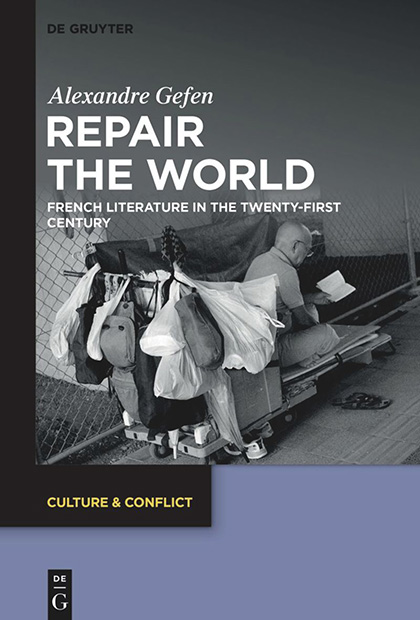Critical Inquiry Critical Inquiry
Alexandre Gefen. Repair the World: French Literature in the Twenty-First Century. Trans. Tegan Raleigh. Berlin: De Gruyter, 2024. 281 pp.
Review by Bogdan Vişan and Ioana Danielescu
24 July 2025
Having inscribed itself within the French cultural milieu, Alexandre Gefen’s 2017 volume, Réparer le monde: la littérature française face au XXIe siècle, now acquires a translated afterlife, enabling a worlding of its critical toolbox and facilitating the transposition of its diagnostic modes beyond the purview of contemporary French writing practices. Its diagnosis of contemporary culture as saturated with psychosomatic practices of repair mediated through the literary invites a mode of reading his work that might be termed a hermeneutics of repair.
In his introduction, the author highlights a shift in contemporary French literature, which is no longer self-sufficient or self-contained as envisioned by structuralist and poststructuralist frameworks. Instead, Gefen emphasizes “the emergence of a notion of writing and reading [he] would describe as ‘therapeutic’––literature that heals, that cares for, that helps, or at least that ‘does good’” (p. 1). In this regard, Repair the World explores the intricacies of six existential challenges––“oneself,” “life,” “trauma,” “disease,” “the world,” and “time”––that literature seeks to address, with writing and reading functioning as therapeutic tools.
The first part of the volume establishes the theoretical framework, centering on the metamorphosis of the contemporary cultural climate into what Gefen terms “the empire of the first person” (p. 17). Bowing to neoliberal logics that sanctify the imperialist ego, identity becomes one’s most valuable commodity, prompting individuals to refine and express it by exploring and emphasizing their autonomous subjectivation. With transitivity as a key feature, the “literature of the I” aims to renarcissize, reaffirm, and singularize the self through the revelation of its distinctiveness (p. 26). In an era marked by proliferating forms of (hyper-) individualism and narcissistic self-fashioning, writers often become their “own spheres of reference, disassociating from any moral or aesthetic issues” (p. 27). In such a framework, the only remaining conceivable source of shame is invisibility.
A defining quality of the resulting remediating literature is its capacity to transform the individual from a powerless object subjected to historical forces into the agentive subject of their own narrative trajectories. Repair the World subsequently articulates an additional function of transitive literary practices, exploring the therapeutic potential of works written by authors such as Michèle Manceaux, Françoise Chandernagor, Pascal Quignard, Annie Ernaux, Virginie Depentes, in the face of “historical sufferings and private trauma” (p. 74). We are urged to notice a stratified cathartic function of literature, in that the author uses this term to refer not only to the direct therapeutic value of verbalizing one’s real experiences but also to the “manner in which the staging of repressed passions is supposed to manage them” (p. 90). Though this purgative function employs a different mechanism, no longer merely attempting to witness, memorialize, or safeguard experiences but also to completely liberate the subject of them, the intended endpoint persists as a modality of psychic and sociocultural healing.
Additionally, contemporary literary studies’ inter- and transdisciplinarity have effectively engaged with clinical and medical perspectives, particularly through the lens of medical humanities, disability studies, biopolitics, and even necropolitics. As such, Gefen explores AIDS narratives and their self-caring aspects in Hervé Guibert's, Pascal de Duve's, and Gilles Barbedette’s works, among others, highlighting their potential to transform writers and readers into “apprentices,” with literature itself becoming “an apprenticeship in death” (p. 102). In this context, Gefen’s hermeneutics of repair aligns with Queer Studies (and with Eve K. Sedgwick’s “reparative reading”), which foregrounds reparative modalities exemplified by queer narratives that seek to both heal and affirm marginalized subjectivities.[1] In addition to its intersection with queer theories, Gefen’s hermeneutics also lines up with Memory Studies, converging around a shared focus on healing historical and personal fractures, as seen in Gefen’s exploration of memorial and mourning narratives in the case of Philippe Forest, Serge Doubrovsky, Olivier Adam, and Catherine Cusset, among others. Together, these theoretical perspectives underscore the multitudinous registers of repair that fall under the scope of Gefen’s hermeneutics.
The author also confronts the sociomaterial world by exploring the quest for “reconstructing territories” (in the work of authors such as Richard Millet, Pierre Michon, or Pierre Jourde) and “remaking community” (as explored by François Bon, Joseph Kessel, or Florence Aubenas, to name a few), attempting a cartography of geographical, ecological, and communitarian literary approaches through “a materialist and documentary poetics.” (p. 181) However, Gefen’s hermeneutics of repair occasionally overlooks capitalist incursions that undergird various detrimental conditions which contemporary narratives endeavor to confront. This perspective may risk constraining a comprehensive analysis of the economic underpinnings of any traumas that these narratives aim to mend. Nonetheless, his historical treatment of recent cultural and mental permutations generally suffices as a foundation for his inquiry.
To Gefen’s merit, his (post-) criticism can be extended beyond French literature to encompass world literature, as both core and (semi-) peripheral literary systems increasingly reflect the reparative role he identifies in his examples. The need for repair is particularly relevant in the context of contemporary challenges, including the genocide in Gaza and the war in Ukraine, the global rise of far-right extremism, and the ongoing ecological crisis. The contemporary French literature that Gefen analyzes, aligning with Rita Felski’s call to consider “the uses of literature in everyday life,” emerges from what can be termed Therapyland.[2] This metaphor not only reflects the therapeutic turn in contemporary literature but also gestures toward a broader shift in literary criticism, one that emphasizes reparative practices in its attempt to face the contemporary world. Ultimately, this volume highlights a hermeneutics of repair that remains deeply engaged with addressing the fractures created by the ongoing polycrisis.
[1] Eve Kosofsky Sedgwick, “Paranoid Reading and Reparative Reading; or, You’re So Paranoid, You Probably Think This Introduction Is about You,” in Novel Gazing: Queer Readings in Fiction ed. Sedgwick (Durham, N.C., 1997), pp. 1–37.
[2] Rita Felski, The Limits of Critique, (Chicago, 2015), p. 191.

